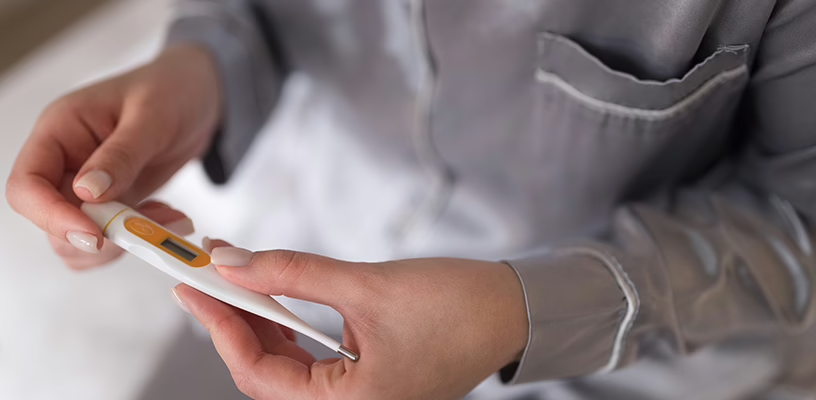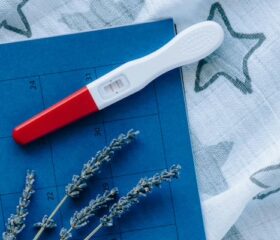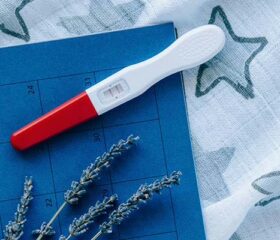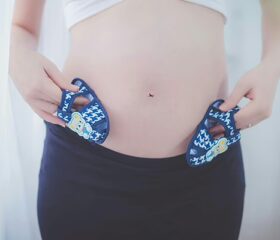Understanding the Basal Body Temperature (BBT) Method
If you’ve been tracking your fertility for a while, you may have heard of the basal body temperature (BBT) method.

It might sound strange, but many women use their basal body temperature (i.e., their lowest body temperature) to identify when they’re entering their fertile window each month.
Keep reading to learn how your body temperature plays a role in your fertility, how to use this method for conception (or contraception), and how reliable it really is.
What is your basal body temperature?
Your basal body temperature (BBT) is your body’s lowest temperature when it’s completely at rest (in contrast to your “regular” body temperature, which fluctuates throughout the day as you exercise, eat and drink, and do other everyday things).
To get an accurate baseline, you should take your temperature first thing in the morning, after you’ve had several hours of sleep and before you even get out of bed or engage in any physical activity. 1
What is the BBT method and how can it predict ovulation?
The BBT method is a natural family planning technique where you track your daily temperature to identify when you’re most fertile, meaning when you’re most likely to get pregnant.
The idea is that your temperature follows a pattern as you go through the different phases of your menstrual cycle and may spike just before you ovulate. That’s when your ovaries release an egg that’s ready to be fertilized.
Once your egg is released, it’s viable for less than 24 hours. Sperm can live in your body for up to 5 days. 2 This means that if you want to conceive, you should have unprotected sex within 5 days of ovulation (this is known as your “fertile window”).
By paying attention to when your BBT dips and rises, you can supposedly gauge when this window is approaching.
How your BBT changes throughout your cycle
In more detail, proponents of the BBT method believe that your temperature changes as you pass through these stages of your monthly menstrual cycle: 3
- Follicular phase: This lasts from the first day of your period until ovulation (which, again, is when your egg drops into your fallopian tube to get fertilized). Proponents of the BBT method say that during this phase, your BBT will normally be between 96 and 98 °F.
- Luteal phase: After ovulation, the release of the hormone progesterone may cause a slight but noticeable increase (or “thermal shift”) of 0.4 to 0.8 °F—bringing your BBT up to around 97 to 99 °F. Your BBT will stay elevated for the rest of this phase, which lasts until your period starts again.
- Menstruation: Your BBT will drop back down to your pre-ovulation levels just before your period begins again. 4 Note that it could be an early sign of pregnancy if your BBT remains elevated (and you don’t get your period on time).
These patterns aren’t universal. They differ somewhat from woman to woman and even from month to month.
When you use the BBT method, you chart your BBT over several menstrual cycles. The goal is to identify your body’s unique patterns and, eventually, come to learn what telltale rises and dips suggest you’re entering your fertile window.
Can your BBT indicate whether you’re pregnant?
Along with tracking their BBT to identify ovulation, many women use this method to determine whether they’re pregnant.
Supposedly, your BBT noticeably drops when implantation occurs (when a fertilized egg implants into your uterine lining). Many women refer to this change in BBT as the implantation dip.
However, this is by no means an accurate method for confirming pregnancy. The only truly reliable way to determine whether you’re expecting is to take a pregnancy test.
Does the BBT method actually work?
BBT charting is extremely popular. Unfortunately, the scientific evidence for it is fairly weak.
Studies have found that the way that BBT rises and falls varies enough that for many people, this method isn’t reliable. 5 It’s on especially shaky footing for women tracking their ovulation with irregular periods. 4
Moreover, a lot of other factors affecting your fertility (beyond your menstrual cycle) can affect your BBT, including: 637
- Alcohol consumption or smoking
- Sleeping poorly
- Stress
- Starting or stopping oral contraceptives
- Traveling (especially across time zones)
Even if you’re one of the women with fairly regular BBT patterns, these confounding factors make getting consistently accurate measurements quite difficult.
Is it worth charting your BBT?
Proponents of BBT charting claim that it’s a natural, hormone-free way to track your cycle for those who prefer to avoid costly fertility tools or hormonal contraception (and their side effects).
Even though the method isn’t perfectly reliable, that doesn’t necessarily mean you shouldn’t do it. Just be careful not to rely on it, especially exclusively. If you’re trying to get pregnant, use it in combination with other methods of predicting your ovulation (we’ll describe several of these below).
Don’t use BBT charting as a contraceptive method
Not much can go wrong if you’re using this method to conceive. If you don’t get pregnant, you can simply try again later. However, it’s dangerous if you’re looking to prevent pregnancy. It just isn’t as reliable as other methods, and it also doesn’t protect you from sexually transmitted infections. If you’re using the BBT method for birth control, combine it with barrier contraceptives (e.g., condoms, diaphragms, cervical caps, etc.), intrauterine devices (IUDs), or implants.
How do you use the BBT Method?
If you decide to give the BBT method a try, here’s how to use it:
1. Choose the right thermometer
You’ll need a special basal thermometer that measures temperature to at least one-tenth of a degree (two decimal places). The extra decimal places mean that you’ll be able to spot the subtle temperature changes that may be associated with ovulation.
You can find these thermometers at most drugstores or buy them online.
2. Check your temperature consistently
To get useful readings, you’ll need to be consistent in three major ways:
- Timing: You should take your temperature every morning once you’ve had several hours of rest.
- Physical activity: Take your temperature before getting out of bed or doing anything else, including talking. Keep your thermometer next to your bed so you don’t have to get up to reach it.
- Measurement site: You can measure your BBT orally (under the tongue), rectally, or vaginally. The important thing is to stick to the same method each day for accurate results.
If you’re using a glass BBT thermometer and your temperature is between two marks, go with the lower number. 2
Using the BBT method as a shift worker
You can still use this method if you’re a shift worker (meaning your schedule might be more variable than most people’s and you might not go to bed at the same time every day, etc.). However, being consistent will be more challenging.
If you can’t measure your temperature in the morning, take it after your longest period of uninterrupted sleep and continue to record it within an hour of that time every day. 8 Consider setting an alarm for that time if your bedtimes are variable.
3. Record your temperature
Use a paper chart or ovulation tracker app to record your daily BBT. This will help you visualize your temperature patterns over time.
As mentioned, your BBT may rise after ovulation. Women who are looking for this thermal shift usually follow the three over six rule to confirm that ovulation occurred.
This rule states that ovulation is associated with three consecutive days of elevated BBT readings that are higher than the previous 6 days. 9 Remember that this isn’t an exact science and every woman’s body is unique.
Other tools and methods for tracking fertility
Because BBT charting isn’t completely reliable, it’s a good idea to supplement it with other methods:
- Cervical monitoring: You can often predict ovulation by monitoring changes in your cervix. Your cervical discharge during ovulation becomes clear and stretchy (many women even claim their discharge resembles raw egg whites). 10 Your cervix itself also becomes softer and moves higher up. 11
- Ovulation test strips: You can use ovulation test strips—also known as ovulation predictor kits (OPKs)—to detect hormone surges that happen around ovulation, either by looking for estrogen in your saliva or luteinizing hormone (LH) in your urine. These ovulation tests are accurate and can be very useful to narrow down your fertile days.
- Ovulation calculators: There are online tools that can give you a rough estimation of when you’ll ovulate, which usually happens midway through your cycle. 12 For instance, you’ll ovulate around day 14 in a typical 28-day cycle.
- Fertility tracking apps: These types of apps are designed to let you track your BBT, your symptoms throughout your menstrual cycle, changes to your mucus and cervical position, and your OPK results. They can also condense this information into charts and offer sophisticated predictions.
If you’re trying to get pregnant, schedule a preconception appointment with your doctor and ask how to use and understand these tools.
Final thoughts
The BBT method can be a useful tool for understanding your fertility and planning for (or preventing) pregnancy, but it doesn’t work perfectly, so if you use it, take the results with a grain of salt.
Always consult with your doctor to discuss your family planning options and determine the best approach for your needs.
Article Sources
- MedlinePlus. "Definitions of Health Terms: General Health" Retrieved July 1, 2025.
- MedlinePlus. "Pregnancy - identifying fertile days" Retrieved July 1, 2025.
- Office on Women's Health. "Trying to conceive" Retrieved July 1, 2025.
- StatPearls. "Physiology, Ovulation And Basal Body Temperature" Retrieved July 1, 2025.
- Fertility and Sterility. "Accuracy of Basal Body Temperature for Ovulation Detection" Retrieved July 1, 2025.
- Penn Medicine. "News and views" Retrieved July 1, 2025.
- American Pregnancy Association. "Natural Family Planning: Fertility Awareness Method" Retrieved July 1, 2025.
- Natural Womanhood. "FAM Basics: Basal Body Temperature (BBT)" Retrieved July 1, 2025.
- Couple to Couple League International. "NFP Primer for Learning Couples" Retrieved July 1, 2025.
- Cleveland Clinic. "Cervical Mucus" Retrieved July 1, 2025.
- Texas Health Resources. "Ovulation" Retrieved July 1, 2025.
- Medical News Today. "When do you ovulate? Duration and symptoms" Retrieved July 1, 2025.






